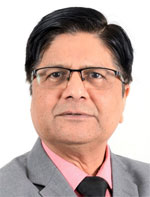|
Preparing For Global Markets: Basics of regulatory
framework for Medical Devices
|

Mr. Amit Dave,
M. Pharm, MBA,
Former CEO - Brazil Operations/ Vice President Export
– Zydus Cadila/Claris Lifesciences |
Regulatory strategy for an
organization From Regulatory
point of view, Covid pandemic has brought high
awareness about quality aspects of devices, mainly the
devices used for Covid but also, all other MDs in
general. Along with awareness, connections and
coordination amongst Regulatory authorities of various
countries have also increased, again, primarily for
Covid related developments but the same coordination
is helping them exchange more information.
As mentioned earlier, in Regulatory
scenario of the countries of the world, there are two
extremes. On one side, least restrictions while on the
other side, there are stringent regulations. The World
Health Organization (WHO) is trying to achieve a
harmonized system, but this harmonization is going to
be achieved over a very long-term. Though this
harmonization plan looks easily implementable
immediately, it will not be implemented soon. These
country-wise differences, therefore, will remain a
challenge for the exporters. In the future articles,
we will discuss these differences also. |
For an organization, developing a
Regulatory program needs vision of the management,
resources, and manpower. Implementation of such a
program is painful mainly because the resources needed
are immediate while results will be visible and bear
fruits after months or years. Sometimes developing a
Regulatory framework may challenge the existing norms of
manufacturing and systems and no organization would like
this. The experience of this author is, however, that
once the basic framework is achieved, to expand further
on that base is not difficult.
QRS Model - Broad Regulatory
Framework
Our readers would certainly be familiar with the new
norms prescribed in India for Medical Devices
Registration. We will discuss overseas regulations from
that starting point of Indian norms. As seen earlier,
Device Regulations have been defined as measures that
governments take to ensure the safety, efficacy, and
quality of the medical products, including relevance and
accuracy of product information.
The standard model for Regulatory framework of almost
all the countries in the world follow a model called QRS
Model. Here-
Q denotes Quality
R represents Risk, and
S mentions systems
…pertaining to a specific product / product bundle.
QRS model is followed by Product specific norms and
Handling norms. The total model is thus denoted by QRS +
HP system.
Let us understand this basic model in more detail. Since
the products in Medical Devices category have wide and
wild variations in them, in this article we will still
understand the broader outline. Soon we will approach
specifics in the coming articles, for sure.
Q denotes Quality
Initially quality was defined as “fitness for use” but
now a broad definition is “activities designed to
maintain a desired level of excellence” for a product.
The word Quality has graduated where now, the ultimate
test is excellence, not mere usage. A product will have
to be fit for usage purpose and should tend to be an
excellent product for its purpose. And who will know the
quality standards for a product better other than you,
its manufacturer or a marketeer? A manufacturer will
know how to test the quality standards as well as
possible gaps and how to ensure that those gaps do not
affect product’s expected ultimate usage. In the
forthcoming articles, the basic parameters for Quality
will be expanded and connected with regulatory norms for
specific countries.
R represents Risk
Risk management for medical devices is well covered in
the Definition of ISO 14971. All products and processes
do have risks and risks cannot become zero, though
ideally it should be that way. In the sum, Benefits of a
product must outweigh Risk, and for that assessment, the
manufacturer should assess Risk of his products. This
ISO 14971 gives guidance for risk identification,
analysis, evaluation as well as control and management
for reducing risk. Not only that, procedures during and
after production for risk management are also explained.
Risk has two components – Degree and Possible Frequency,
and these components become product and process
specific.
S for Systems
A product is a final output result of sum of all the
inputs. These inputs include product specific inputs
like components, ingredients, etc and human efforts as
well as processes being followed. Each input may have
sub-inputs. How is a component procured, stored,
checked, and processed for making the final product?
This is the broad framework of process. Production
control and process control are the basics of the system
control. After understanding this broad frame, we will
aim for specifics in the next articles. |
